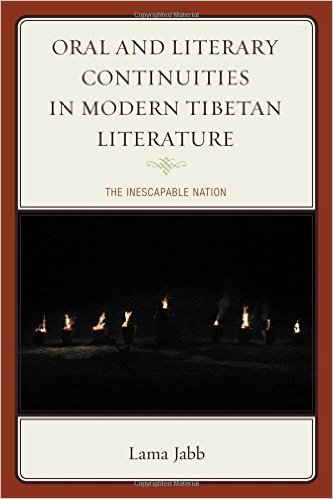
High Peaks Pure Earth presents a guest post by Jonathan Mirsky, a book review of “Oral and Literary Continuities in Modern Tibetan Literature: The Inescapable Nation” by Lama Jabb, published in June 2015 by Rowman and Littlefield.
Lama Jabb’s book was featured on the High Peaks Pure Earth Reading List last year. This summer’s reading list will be online soon!
Thank you to Jonathan Mirsky for contributing this book review. Jonathan Mirsky is a journalist and regular contributor to the New York Review of Books. Read his other book reviews for High Peaks Pure Earth here: http://highpeakspureearth.com/tag/jonathan-mirsky/
“Oral and Literary Continuities in Modern Tibetan Literature: The Inescapable Nation”
By Lama Jabb
Review by Jonathan Mirsky
After six trips to Tibet between 1981 and 1989 and writing thousands of words on what happened there after the Chinese invasion in 1950, is it stupidity or ignorance that kept me from knowing anything about Tibetan literature? From Lama Jabb’s fascinating book I see at last that literature has been an outstanding tool in Tibetan resistance to China’s cultural evisceration.
I was not surprised to hear that Tibet has a long and varied literary tradition of poetry and prose, nor that this tradition has influenced writing in modern times. Where is this not true? But after a survey of this literature’s many forms, which requires learning the wholly unfamiliar names of many authors and genres, both past and present, what amazes me is how bravely and often cleverly Tibetans writers today use metaphor and traditional themes to lambast the Chinese occupiers. They are taking a considerable risk of imprisonment; written criticism of Communist rule whether in China proper, in the parts of China where many Tibetans live, or in Tibet proper, can lead to serious punishment.
Born into a nomadic tribe in Amdo, northeastern Tibet, Lama Jabb is now a PhD with a fellowship at Wolfson College, Oxford. Unlike some other foreign students he has not adopted an academic coded language almost forbidden to outsiders. A considerable amount of what he learned and quotes here, he learned form his mother, who sounds remarkable. He has two main themes: that its long and varied literary tradition continues to inform Tibetan literature today, and that allusion – to past themes and language – is used, metaphorically, to condemn China today. Using an ancient form called “kayva,” a contemporary female poet wrote:
“Something unnameable is falling ever so softly
Is it the last tears you’ve left for this world?…
But when extremely sad
To shed tears is quite another matter.”
“This abstract elegy, “ Jabb tells us, “ …is a coded allusion to the activism of fiery self-immolations spearheaded by the Tibetan clergy inside Tibet since 2009,” [9]– the well over 100 deaths have been examined in detail in Tsering Woeser’s most recent book, “Tibet on Fire,” – and will be widely read and understood by Tibetans who have access, these days, to electronic means for tuning into subversive literature – as can China’s Tibetan informers, which means even such reading is perilous.
More evocative, still, for most Tibetans, is a long poem about the wild yak, a vanishing species under Chinese rule, whose skin was used for centuries by nomads who in recent years have been driven from their pastures. The unity of “elegy and dirge rolled into one,” […] “mourns the demise of a glorious past generation…who have stood up against advancing Chinese forces in the 1950s.” [99] Here is a sample:
“Before the blowing of the red wind, wild yaks stampeded across yonder pass
Today my grandfather is staring at the pass, remembering
A wild beast called the wild yak…
Does that wild beast called the wild yak, over so many years gone by
Today remain silent beneath the land under your feet?
…. No one has tamed the wild yak
no one can turn the wild yak into a slave-like domestic animal
As the wild yak is not broken into a slave mentality…
It has never bowed down before anyone
The wild yak has no habit of bowing down…
The wild yak has an absolute resolve to rise up against you
The wild yak turns a deaf ear to your violent guns… [ 99-100]
Lama Jabb puts it well: “the frequent use of metaphors such as ‘red wind,’ and ’wild yak,’ and their status as unifying imageries, demonstrate how cultural trauma serves as a rallying point for the Tibetan people…these figurative expressions reinforce Tibetan solidarity.”[137] I’m sure they do, and I am grateful to Lama Jabb for raising the curtain on this intense and tragic drama.
There are other traditional-modern themes as well, notably erotic poetry, which happily is not riddled with political metaphors. The famous Gedun Choepel wrote,
“I am indeed insane these days
Those still sane may laugh at me
Yet it’s no small matter to feel bliss…
To nurture passion with blissful emptiness.” [186]
This poem, writes Lama Jabb – and I am glad to know this, too – “is one long poetic composition featuring instructions on sexual techniques…descriptions of carnal ecstasy verging on nirvanic bliss…” [186]
Buy the book on Amazon here: http://amzn.to/1fFtFem





Hello. I’m wondering if High Peaks Pure Earth will be publishing a review of my book TIBET ON FIRE: BUDDHISM, PROTEST, AND THE RHETORIC OF SELF-IMMOLATION. I see Jonathan Mirsky has reviewed Michael Buckley’s book and has just written about a study of Tibetan literature. http://www.palgrave.com/us/book/9781137373731 Please let me know if you have difficulty obtaining a review copy.
Thank you, John Whalen-Bridge.